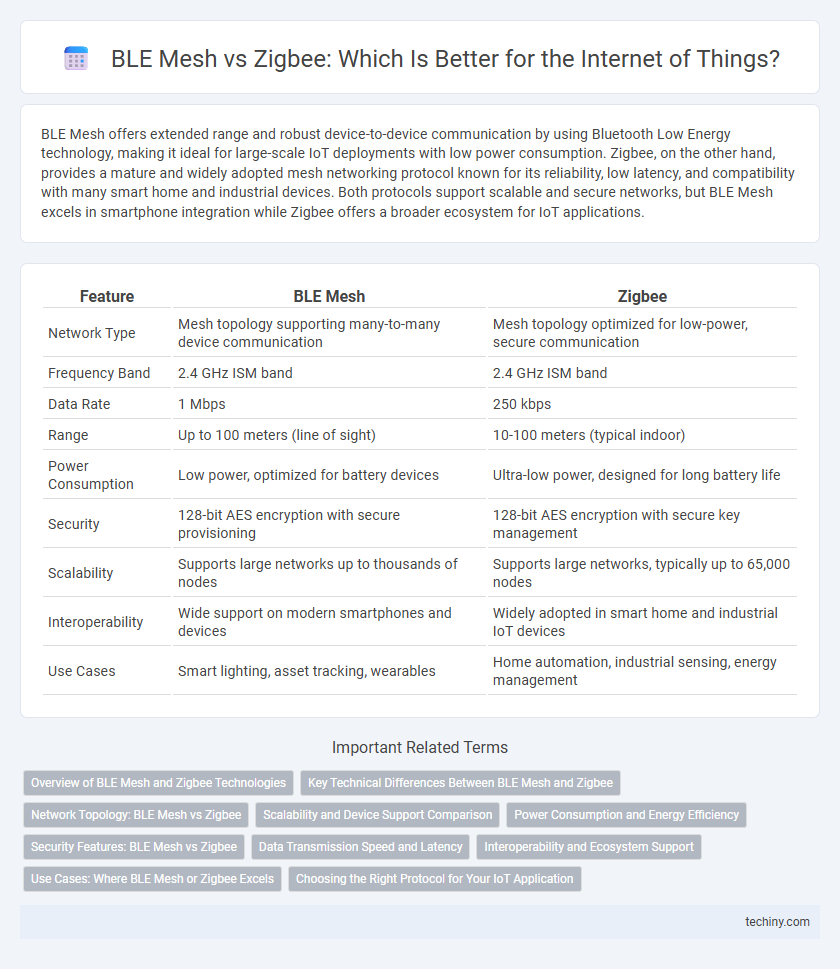BLE Mesh offers extended range and robust device-to-device communication by using Bluetooth Low Energy technology, making it ideal for large-scale IoT deployments with low power consumption. Zigbee, on the other hand, provides a mature and widely adopted mesh networking protocol known for its reliability, low latency, and compatibility with many smart home and industrial devices. Both protocols support scalable and secure networks, but BLE Mesh excels in smartphone integration while Zigbee offers a broader ecosystem for IoT applications.
Table of Comparison
| Feature | BLE Mesh | Zigbee |
|---|---|---|
| Network Type | Mesh topology supporting many-to-many device communication | Mesh topology optimized for low-power, secure communication |
| Frequency Band | 2.4 GHz ISM band | 2.4 GHz ISM band |
| Data Rate | 1 Mbps | 250 kbps |
| Range | Up to 100 meters (line of sight) | 10-100 meters (typical indoor) |
| Power Consumption | Low power, optimized for battery devices | Ultra-low power, designed for long battery life |
| Security | 128-bit AES encryption with secure provisioning | 128-bit AES encryption with secure key management |
| Scalability | Supports large networks up to thousands of nodes | Supports large networks, typically up to 65,000 nodes |
| Interoperability | Wide support on modern smartphones and devices | Widely adopted in smart home and industrial IoT devices |
| Use Cases | Smart lighting, asset tracking, wearables | Home automation, industrial sensing, energy management |
Overview of BLE Mesh and Zigbee Technologies
BLE Mesh enables extensive device-to-device communication in IoT networks through a decentralized, many-to-many topology, supporting low-power, long-range, and scalable connectivity. Zigbee operates on a mesh network protocol built on IEEE 802.15.4 standards, designed for low-data-rate, low-power applications with robust security features and interoperability for smart home and industrial automation. Both technologies cater to IoT environments requiring reliable, energy-efficient connectivity but differ in protocol stack complexity and ecosystem compatibility.
Key Technical Differences Between BLE Mesh and Zigbee
BLE Mesh operates on Bluetooth Low Energy protocol supporting up to 32,767 nodes with managed flooding for message transmission, optimizing power efficiency and range. Zigbee utilizes the IEEE 802.15.4 standard, enabling mesh networks with support for thousands of nodes through a tree and cluster-tree topology, offering lower latency and robust security features. BLE Mesh excels in smartphone integration and easier deployment, while Zigbee provides more mature network standardization and broader compatibility with industrial devices.
Network Topology: BLE Mesh vs Zigbee
BLE Mesh utilizes a managed flood network topology optimized for many-to-many device communication, enabling robust and scalable connections across extensive areas. Zigbee employs a coordinator-router-end device topology, facilitating organized routing paths that enhance network reliability and energy efficiency. BLE Mesh offers simplified device provisioning and self-healing capabilities within the mesh, while Zigbee emphasizes structured hierarchy for better control and interoperability in complex networks.
Scalability and Device Support Comparison
BLE Mesh supports thousands of nodes with a robust scalability model ideal for large IoT networks, whereas Zigbee typically manages up to 65,000 devices but is often limited by network complexity and interference. BLE Mesh features strong device support due to its integration with Bluetooth LE standards, enabling broad compatibility across smartphones and IoT devices. Zigbee excels in legacy IoT systems with extensive device interoperability but may face scalability challenges in highly dense environments.
Power Consumption and Energy Efficiency
BLE Mesh networks exhibit significantly lower power consumption compared to Zigbee due to their optimized low-duty-cycle communication and efficient advertising mechanisms. Zigbee, while robust in mesh networking, generally consumes more energy because of constant channel scanning and higher communication overhead. Energy efficiency in BLE Mesh makes it ideal for battery-powered IoT devices requiring extended operational life.
Security Features: BLE Mesh vs Zigbee
BLE Mesh incorporates strong encryption using AES-128 CCM for authentication and privacy, ensuring secure message transmission across nodes. Zigbee also utilizes AES-128 encryption but enhances security with network key management and device-specific link keys for more granular access control. Both protocols support integrity checks, but Zigbee's centralized trust center provides advanced security features like key revocation and dynamic key updates.
Data Transmission Speed and Latency
BLE Mesh typically offers higher data transmission speeds compared to Zigbee, facilitating faster communication in IoT networks. Zigbee, while generally slower, provides lower latency, which is crucial for time-sensitive applications. Both protocols optimize network efficiency, but BLE Mesh excels in throughput, whereas Zigbee is preferred for minimal delay in device interactions.
Interoperability and Ecosystem Support
BLE Mesh offers broad interoperability with smartphones and consumer devices due to its foundation on the widely adopted Bluetooth standard, enabling seamless integration across diverse IoT ecosystems. Zigbee, built specifically for low-power mesh networking, benefits from a mature ecosystem with extensive vendor support, especially in smart home and industrial automation sectors, ensuring reliable device compatibility and network scalability. While BLE Mesh excels in mobile device interaction, Zigbee provides robust interoperability within specialized IoT environments, making each suitable for different interoperability and ecosystem requirements.
Use Cases: Where BLE Mesh or Zigbee Excels
BLE Mesh excels in large-scale environments requiring extensive device-to-device communication with low power consumption, making it ideal for smart lighting and asset tracking in industrial settings. Zigbee performs exceptionally well in home automation and smart energy management systems, offering robust mesh networking with high data reliability and low latency. Both protocols support scalable IoT applications, but BLE Mesh is favored for mobile device integration, while Zigbee is preferred for stable, fixed-device networks.
Choosing the Right Protocol for Your IoT Application
Choosing the right protocol for your IoT application hinges on factors like network range, device density, and power consumption. BLE Mesh offers extended range and low energy usage, ideal for smart home devices requiring reliable communication across multiple nodes. Zigbee excels in scalability with robust security features, making it suitable for industrial IoT networks demanding high device density and interoperability.
Ble mesh vs Zigbee Infographic

 techiny.com
techiny.com